We’ve been talking quite a bit about parrots and Guyana lately. One woman with a passion for both and a fascination with the natural world rivaled only by her eloquence in sharing it with others is Julie Zickefoose. You probably know Julie through her artwork, her NPR commentary, or maybe even the heavenly Letters From Eden, which I frankly loved. You may read or subscribe to her endlessly entertaining blog. If you haven’t yet made Julie’s acquaintance, the following guest post is a splendid introduction to a naturalist you’ll want to know better!
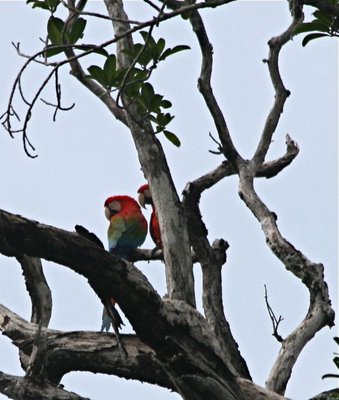 Red and Green Macaws, Iwokrama Reserve, Guyana, South America
Red and Green Macaws, Iwokrama Reserve, Guyana, South America
Macaws, as a group, are not the best dispersers of plant seeds. They’re usually seed predators, slicing through ripe fruit to eat the seeds. When I hand a quarter of apple to Charlie, my 22-year-old chestnut-fronted macaw, he macerates it, reducing it to shreds, digging to the core. He obviously enjoys the apple seeds as much as or more than the fruit. Macaws are spectacularly messy eaters, and once they’ve dropped something to the forest floor, they don’t go down and pick it up. Even homemade bread, right, Charlie?
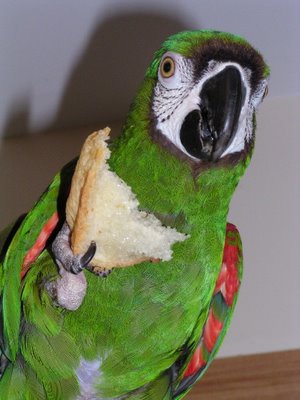 Charlie, my Chestnut-fronted Macaw (Ara severa)
Charlie, my Chestnut-fronted Macaw (Ara severa)
I told Charlie’s story on National Public Radio back in March. He’s captive-raised. He’s been with me for 22 years. And every time I see parrots in the wild, I wish hard that I could set him free.
Plants make juicy sweet fruits in order to tempt animals and birds to eat them, and by doing so swallow and later disperse their seeds. They don’t “want” their precious seeds to be eaten. So seeds often carry a toxic load to discourage seed predators like macaws. Ah, but the macaws are one step ahead of the plants whose seeds they enjoy. Tim Ryan’s (ravishing) guest post about the clay licks of Tambopata shows one way psittacines combat toxins in their system–by eating nutrient-rich clay that also helps neutralize phytotoxins!
There are exceptions to this seed predator role, however, and an encounter with a large flock of Red-shouldered Macaws (Ara nobilis) at Rockview Lodge in Guyana, South America proved to be one. Several huge mango trees on the lodge grounds were coming ripe when I stayed there in November, 2008, and the macaws were all over the still-green fruits like the white on rice.
Ara nobilis is the smallest of the macaws, smaller even than some of the Aratinga parakeets (conures, in the pet trade). It has an accordingly shrill, cakky voice, and it was easy to find red-shouldered macaws wherever we went in Guyana, from the urban Georgetown Botanical Garden to the darkest interior.
This flock was putting a big hurt on some ripening mangoes.
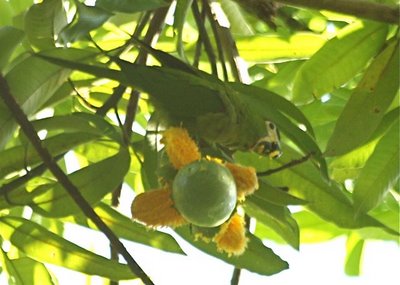 Eating all the nice flesh and leaving the seed to dry on the tree is probably not quite what the mango had in mind. Which leads me to wonder: what is the mango’s preferred agent of dispersal? I’m guessing howler and capuchin monkeys, which could carry an entire fruit some distance away before devouring it and dropping the seed. Macaws are breaking the dispersal rules, but I doubt that concerns them. Macaws love to break rules (she wrote, gazing at the shredded pages of her Sibley Guide to Birds and Audubon Encyclopedia of North American Birds.)
Eating all the nice flesh and leaving the seed to dry on the tree is probably not quite what the mango had in mind. Which leads me to wonder: what is the mango’s preferred agent of dispersal? I’m guessing howler and capuchin monkeys, which could carry an entire fruit some distance away before devouring it and dropping the seed. Macaws are breaking the dispersal rules, but I doubt that concerns them. Macaws love to break rules (she wrote, gazing at the shredded pages of her Sibley Guide to Birds and Audubon Encyclopedia of North American Birds.)
Other species, like this Palm Tanager, are the beneficiaries of the macaws’ work.
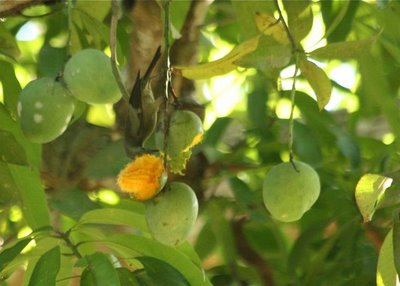 A palm tanager probably wouldn’t be able to pierce a mango’s thick skin without help, but they eagerly move in where the macaws have been.
A palm tanager probably wouldn’t be able to pierce a mango’s thick skin without help, but they eagerly move in where the macaws have been.
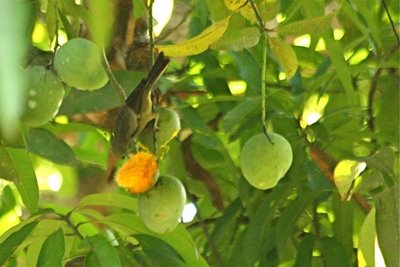
This young Red-shouldered Macaw begged noisily from its parent, who was busy stripping mango flesh off the seeds.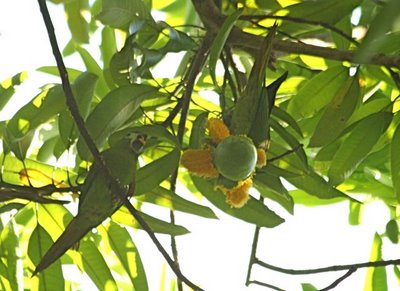
Parrots in captivity are usually kept one to a cage. They rely on their human companions to fulfill their social needs, something at which we do an admittedly imperfect job.
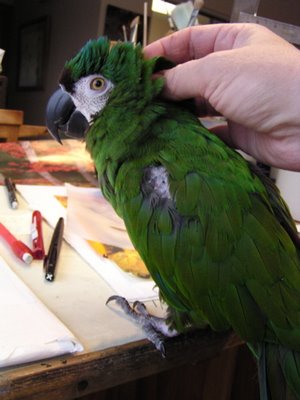
When you see parrots in the wild, you realize how they were made to live. They’re never alone, and what’s more, they’re forever messing with each other, allopreening and squabbling and playing and tussling. Family bonds are intense and long-lasting.
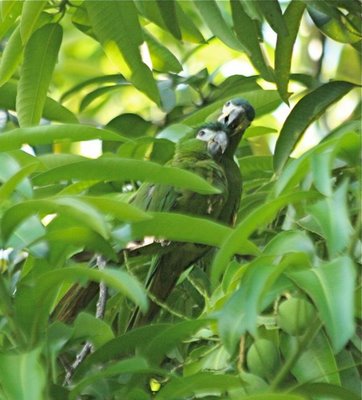 I watched and shot photos as best I could as the adult preened its fledgling all over. I can attest that the wingpit and tail base are a macaw’s two favorite places to be tickled. Charlie raises his wing just like this when I preen him there.
I watched and shot photos as best I could as the adult preened its fledgling all over. I can attest that the wingpit and tail base are a macaw’s two favorite places to be tickled. Charlie raises his wing just like this when I preen him there.
Soon the rest of the family crowded around and everyone got a good preening. I was heartened to see this adult caring for three youngsters; glad these little macaws were doing their best to keep the mangoes stripped and the air full of their happy screeches.
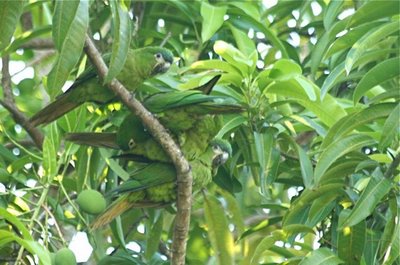 It’s been nice to write this post with a macaw on my shoulder, preening away, occasionally sticking his warm rubbery tongue in my ear-oo! And yet I’m wistful, knowing that he’ll never live the way he was meant to live, in a flock of his own kind, raising his own kids and tearing up mangoes in the top of a tree. There’s no way I can be a whole flock to Charlie, but I do my best.
It’s been nice to write this post with a macaw on my shoulder, preening away, occasionally sticking his warm rubbery tongue in my ear-oo! And yet I’m wistful, knowing that he’ll never live the way he was meant to live, in a flock of his own kind, raising his own kids and tearing up mangoes in the top of a tree. There’s no way I can be a whole flock to Charlie, but I do my best.
All words and images by Julie Zickefoose


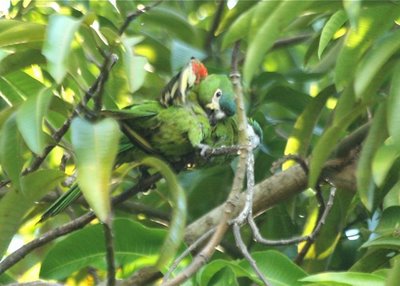
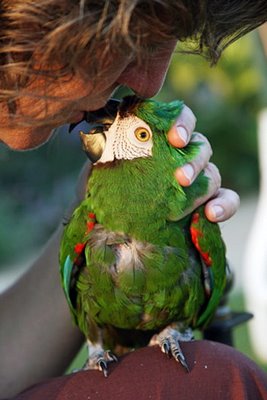











Great post, Julie, thanks so much.
Thanks for this, Mike. I’ve known Julie for almost three years and have read every post she cooks up for us. Fabulous, every one of them! I can’t get enough of Charlie and Julie’s adventures.
Mary
In its native range, the mango is primarily dispersed by elephants, at least according to what I read in The Ghosts of Evolution by Connie Barlow. Bit hard to come by elephants in South America though.
Woo, Carrie, thanks for the wake-up! Mangifera indica, duhh…had I just stopped to think of the Latin name and remembered that it’s not even native to the Neotropics, I might have come up with a different dispersal agent. But I wouldn’t have thought of an elephant! I guess passing a mango seed is not for monkey pikers. Just another thing to love about blogging! Thanks so much for letting me ramble on here, Mike, Charlie, and Corey.
By far my favorite parrot post for parrot month. Charlie and his wild buddies remind me of my Illiger’s macaw Rusty.
Julie, thanks so much for the wonderful article and for featuring Guyana and Rock View Lodge http://www.rockviewlodge.com in it. I will have a new appreciation for the macaws in the mango trees on my next visit!
Macaws regularly travel considerable distances to gather at favoured clay licks and eat the soil. The soil may detoxify toxins from some of the plants in the macaws’ diet, and soil eating amy therefore be viewed as a form of self-medication.